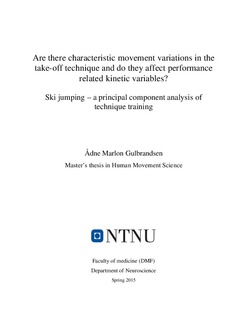| dc.description.abstract | Introduction. Part of technique training in ski jumping consists of land-based simulation jumps: athletes vary their sitting posture following instructions, such as “high”, “low”, “offensive”, or "defensive”, and evaluate the subsequent take-off motions with their coaches. This study addresses three research questions: (1) do different athletes interpret the different instructions in similar ways? (2) What characteristic variations are seen in the take-off kinematics? (3) Do changes in the sitting position and push-off kinematics affect kinetic variables?
Methods. Fourteen ski jumpers completed 21 imitation jumps under 6 different instructions: perfect, high, low, offensive, defensive, and free. The take-off movements were recorded with Oqus motion tracking system using 22 reflective markers distributed on the right extremities, pelvis, spine, and head. Two Kistler force plates recorded ground reaction forces (GRF). A principal component analysis (PCA) was performed on a combination of marker trajectories and kinetic variables. We assessed how changes in movement patterns (principal movements, PMk) correlated with changes in the kinetic variables. The PCA was conducted on the normalised data from all subjects and thus allowed for direct comparisons of movement patterns between subjects.
Results. Despite individual differences, the instructions were interpreted largely similarly by the jumpers. PM1-2 characterised movements due to the sagittal constraint of the take-off, reflected in anterioposterior and vertical whole-body variance throughout the take-off. PM3-6 represented compensation movements in sitting position and push-off due to exaggerations in PM1-2 sitting position. PM7-10 characterised perturbations at the start of push-off. The kinetic variables showed distinct patterns representing the different movement variations.
Conclusion. Results indicated that jumpers interpreted the different instructions similarly. In addition, three distinct groups of movement characteristics were observed in the sitting position, during push-off, or both. Furthermore, movement characteristics and kinetic forces were related, although causality cannot be inferred from the present study. Visualisation of the PMk can help coaches and athletes better understand the often ambiguous descriptions of movement patterns and variations, which again could help in take-off technique training. | nb_NO |
